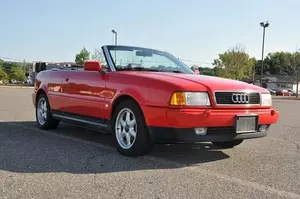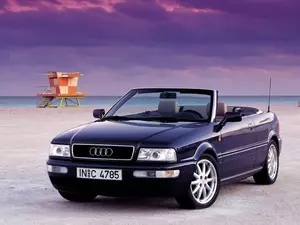
| Vehicle | Precise engine size | Difference from world average | Engine size to consumption ratio | Horsepower from 1 L | Engine size to 100 kg of weight |
|---|---|---|---|---|---|
| 1.8 20V |
1.78 L (1781 cc) |
24.1% smaller | 69 cc to 1 mpg | 70 hp from 1 L | 127 cc to 100 kg |
| 2.6 V6 |
2.6 L (2598 cc) |
10.7% bigger | 124 cc to 1 mpg | 58 hp from 1 L | 186 cc to 100 kg |
| 1.9 TDI |
1.9 L (1896 cc) |
19.2% smaller | 49 cc to 1 mpg | 47 hp from 1 L | 135 cc to 100 kg |
| 2.8 V6 E |
2.77 L (2771 cc) |
18.1% bigger | 132 cc to 1 mpg | 63 hp from 1 L | 198 cc to 100 kg |
| 2.0 E |
1.98 L (1984 cc) |
15.4% smaller | 83 cc to 1 mpg | 58 hp from 1 L | 142 cc to 100 kg |
| Vehicle | 1.8 20V |
|---|---|
| Precise engine size | 1.78 L (1781 cc) |
| Difference from world average | 24.1 smaller |
| Engine size to consumption ratio | 69 cc to 1 mpg |
| Horsepower from 1 L | 70 hp from 1 L |
| Engine size to 100 kg of weight | 127 cc to 100 kg |
| Vehicle | 2.6 V6 |
| Precise engine size | 2.6 L (2598 cc) |
| Difference from world average | 10.7 bigger |
| Engine size to consumption ratio | 124 cc to 1 mpg |
| Horsepower from 1 L | 58 hp from 1 L |
| Engine size to 100 kg of weight | 186 cc to 100 kg |
| Vehicle | 1.9 TDI |
| Precise engine size | 1.9 L (1896 cc) |
| Difference from world average | 19.2 smaller |
| Engine size to consumption ratio | 49 cc to 1 mpg |
| Horsepower from 1 L | 47 hp from 1 L |
| Engine size to 100 kg of weight | 135 cc to 100 kg |
| Vehicle | 2.8 V6 E |
| Precise engine size | 2.77 L (2771 cc) |
| Difference from world average | 18.1 bigger |
| Engine size to consumption ratio | 132 cc to 1 mpg |
| Horsepower from 1 L | 63 hp from 1 L |
| Engine size to 100 kg of weight | 198 cc to 100 kg |
| Vehicle | 2.0 E |
| Precise engine size | 1.98 L (1984 cc) |
| Difference from world average | 15.4 smaller |
| Engine size to consumption ratio | 83 cc to 1 mpg |
| Horsepower from 1 L | 58 hp from 1 L |
| Engine size to 100 kg of weight | 142 cc to 100 kg |

| Vehicle | Precise engine size | Difference from world average | Engine size to consumption ratio | Horsepower from 1 L | Engine size to 100 kg of weight |
|---|---|---|---|---|---|
| 2.6 V6 |
2.6 L (2598 cc) |
10.7% bigger | 113 cc to 1 mpg | 58 hp from 1 L | 173 cc to 100 kg |
| 2.8 V6 E |
2.77 L (2771 cc) |
18.1% bigger | 126 cc to 1 mpg | 63 hp from 1 L | 185 cc to 100 kg |
| 1.9 TDI |
1.9 L (1896 cc) |
19.2% smaller | 45 cc to 1 mpg | 47 hp from 1 L | 135 cc to 100 kg |
| 2.0 E |
1.98 L (1984 cc) |
15.4% smaller | 83 cc to 1 mpg | 58 hp from 1 L | 142 cc to 100 kg |
| 2.3 E |
2.31 L (2309 cc) |
1.6% smaller | 96 cc to 1 mpg | 58 hp from 1 L | 165 cc to 100 kg |
| Vehicle | 2.6 V6 |
|---|---|
| Precise engine size | 2.6 L (2598 cc) |
| Difference from world average | 10.7 bigger |
| Engine size to consumption ratio | 113 cc to 1 mpg |
| Horsepower from 1 L | 58 hp from 1 L |
| Engine size to 100 kg of weight | 173 cc to 100 kg |
| Vehicle | 2.8 V6 E |
| Precise engine size | 2.77 L (2771 cc) |
| Difference from world average | 18.1 bigger |
| Engine size to consumption ratio | 126 cc to 1 mpg |
| Horsepower from 1 L | 63 hp from 1 L |
| Engine size to 100 kg of weight | 185 cc to 100 kg |
| Vehicle | 1.9 TDI |
| Precise engine size | 1.9 L (1896 cc) |
| Difference from world average | 19.2 smaller |
| Engine size to consumption ratio | 45 cc to 1 mpg |
| Horsepower from 1 L | 47 hp from 1 L |
| Engine size to 100 kg of weight | 135 cc to 100 kg |
| Vehicle | 2.0 E |
| Precise engine size | 1.98 L (1984 cc) |
| Difference from world average | 15.4 smaller |
| Engine size to consumption ratio | 83 cc to 1 mpg |
| Horsepower from 1 L | 58 hp from 1 L |
| Engine size to 100 kg of weight | 142 cc to 100 kg |
| Vehicle | 2.3 E |
| Precise engine size | 2.31 L (2309 cc) |
| Difference from world average | 1.6 smaller |
| Engine size to consumption ratio | 96 cc to 1 mpg |
| Horsepower from 1 L | 58 hp from 1 L |
| Engine size to 100 kg of weight | 165 cc to 100 kg |